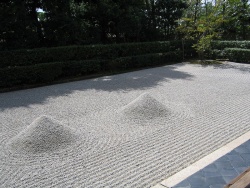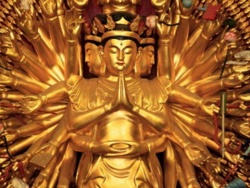History of the Mulasarvastivada Ordination Lineages in Tibet By Alexander Berzin
Although lines of Mulasarvastivada bhikshu ordination were established in Tibet on three occasions, a Mulasarvastivada bhikshuni sangha never became firmly established. Consequently, women following the Tibetan Buddhist tradition within the Mulasarvastivada Vinaya tradition and who have wished to ordain have become shramanerikas or novice nuns.
The first time the Mulasarvastivada bhikshu ordination was established in Tibet was with the visit of the Indian master Shantarakshita, together with thirty monks, and the founding of Samyay (bSam-yas) Monastery in Central Tibet in 775 CE.
This was under the patronage of the Tibetan Emperor Tri Songdetsen (Khri Srong-lde-btsan).
However, because neither twelve Indian Mulasarvastivada bhikshunis came to Tibet at that time, nor did Tibetan women subsequently travel to India to receive higher ordination, the Mulasarvastivada bhikshuni ordination lineage was not established in Tibet during this first period.
According to a Chinese source preserved among the Dunhuang documents, however, one of the secondary wives of Emperor Tri Songdetsen, Queen Droza Jangdron (‘ Bro-bza’ Byang-sgron), and thirty more women did receive bhikshuni ordination at Samyay.
Their ordination would have been conferred by the Chinese bhikshus who were invited to the translation bureau in Samyay in 781 CE.
Since the Chinese Tang Emperor Zhong-zong had decreed in 709 CE that only the Dharmagupta ordination lineage be followed in China, the bhikshuni ordination in Tibet must have been from the Dharmagupta lineage.
Presumably, the ordination was given by the single sangha method and its lineage did not continue after the defeat of the Chinese faction at the Samyay debate (792-794 CE) and its expulsion from Tibet.
During the reign of the Tibetan Emperor Tri Relpachen (Khri Ral-pa can, 815 – 836 CE), the Emperor decreed that no Hinayana texts other than those within the Sarvastivada fold could be translated into Tibetan.
This effectively limited the possibility of ordination lineages other than Mulasarvastivada from being introduced to Tibet.
The Mulasarvastivada bhikshu ordination lineage from Shantarakshita was almost lost with King Langdarma’s repression of Buddhism at the end of the ninth or beginning of the tenth century CE.
Three surviving Mulasarvastivada bhikshus, with the help of two Chinese Dharmagupta bhikshus, revitalized this bhikshu ordination lineage with the ordination of Gongpa-rabsel (dGongs-pa rab-gsal) in Eastern Tibet.
No similar procedure involving Dharmagupta bhikshunis, however, was followed for establishing the Mulasarvastivada bhikshuni ordination at that time through a mixed lineage dual sangha.
[See: The Revival of the Monk Ordination Lineage in Tenth-Century Tibet.]
Gongpa-rabsel’s line of Mulasarvastivada bhikshu ordination was brought back to Central Tibet and became known as the “Lower Tibet Vinaya” (sMad-‘dul) tradition.
In Western Tibet, however, King Yeshey-wo (Ye-shes ‘od), at the end of the tenth-century CE, turned to India to establish, or perhaps re-establish, the Mulasarvastivada bhikshu ordination in his kingdom.
Thus, he invited to Guge in Western Tibet the East Indian Pandit Dharmapala and several of his disciples to establish the second Mulasarvastivada bhikshu ordination)] line.
This line became known as the “Upper Tibet Vinaya” (sTod-‘dul) tradition.
According to the Guge Chronicles, a Mulasarvastivada nun’s order was also established in Guge at this time, and King Yeshey-wo’s daughter, Lhai-metog (Lha’i me-tog), received ordination in it.
However, it is unclear whether this ordination was as a bhikshuni or a shramanerika novice.
In either case, it is also unclear whether Mulasarvastivada bhikshunis were invited to Guge to confer the ordination, and there is no evidence that a Mulasarvastivada bhikshuni sangha became firmly established in Western Tibet at this time.
In 1204 CE, the Tibetan translator Tropu Lotsawa (Khro-phu Lo-tsa-ba Byams-pa dpal) invited the Indian master Shakyashribhadra, the last throne-holder of Nalanda Monastery, to come to Tibet to escape the destruction wrought by the invading Guzz Turks of the Ghurid Dynasty.
While in Tibet, Shakyashribhadra and his accompanying Indian monks conferred Mulasarvastivada bhikshu ordination on candidates within the Sakya tradition, thus starting the third such ordination line in Tibet.
It has two sublineages, one deriving Shakyashribhadra’s ordination of Sakya Pandita (Sa-skya Pan-di-ta Kun-dga’ rgyal-mtshan) and the other from his ordination of a community of monks that he later trained and which eventually divided into the four Sakya monastic communities (tshogs-pa bzhi).
Although there is evidence that there were still bhikshunis in northern India as late as the twelfth century CE, no Mulasarvastivada bhikshunis accompanied Shakyashribhadra to Tibet.
Thus, the Mulasarvastivada bhikshuni ordination lineage was never transmitted in conjunction with any of the three Mulasarvastivada bhikshu ordination lines in Tibet.
In the centuries that have followed Shakyashribhadra’s visit, at least one attempt was made to establish the Mulasarvastivada bhikshuni ordination in Tibet, but it was unsuccessful.
In the early fifteenth-century CE, the Sakya master Shakya-chogden (Sha-kya mchog-ldan) convened a single sangha Mulasarvastivada bhikshuni ordination specifically for his mother. Another contemporary Sakya master, Gorampa (Go-ram-pa bSod-nams seng-ge), however, strongly criticized the validity of this ordination and, subsequently, it was discontinued.

